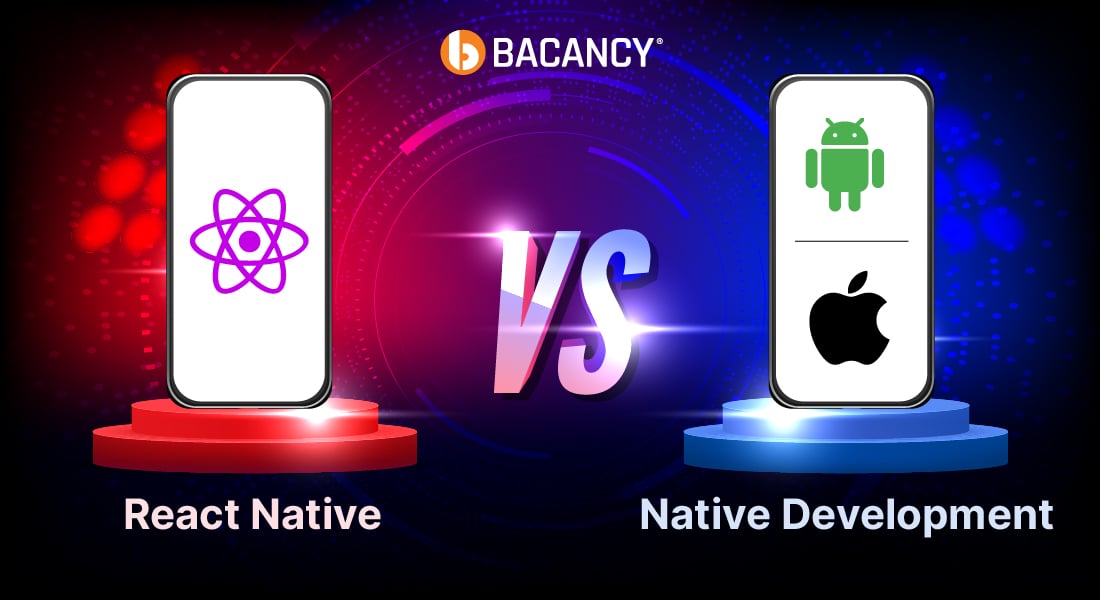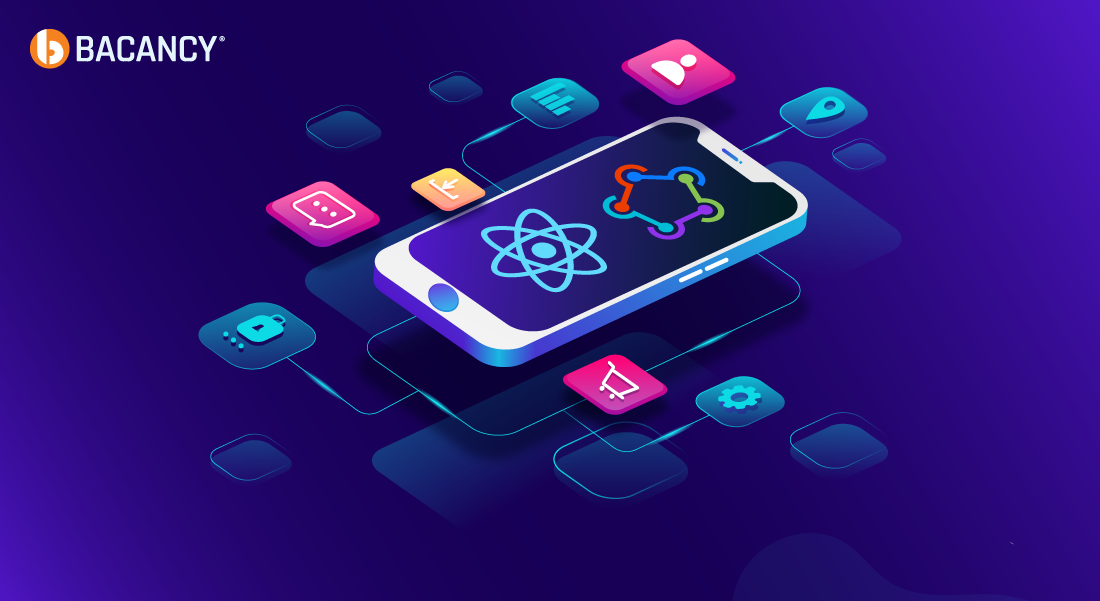Summary:
React Native framework and healthcare application are the two emerging trends among businesses because of their high demand and efficiency. Today, in this blog, we will discuss how using React Native in healthcare applications can be beneficial.
This guide covers features, reasons to choose, challenges, benefits, and future trends of React Native healthcare apps. Keep reading to find the significance of React Native in the healthcare industry.
Table of Contents
Reasons to Choose React Native for Healthcare Apps
React Native is an open-source JavaScript framework introduced by Facebook. As a cross-platform development tool, you can use it to build mobile apps for versatile platforms and web applications.
Well! There are numerous cross-platform app development tools like React Native, and all of them can be used to build healthcare apps. However, you should prefer React Native for healthcare apps due to several reasons – some of which are mentioned below.
- React Native simplifies development with reusability and code maintenance.
- Using React Native for cross-platform development helps you save up to 50% in development costs compared to native app development.
- You can build a healthcare mobile application using a single code.
- It derives substantial elements from React (a JavaScript library), making it the preferred choice for building intuitive user interfaces.
Features of React Native Healthcare Apps
After understanding why to opt for React Native in mobile healthcare apps, let us discuss some of the dynamic features of React Native healthcare apps that enhance your app’s performance and user experience.
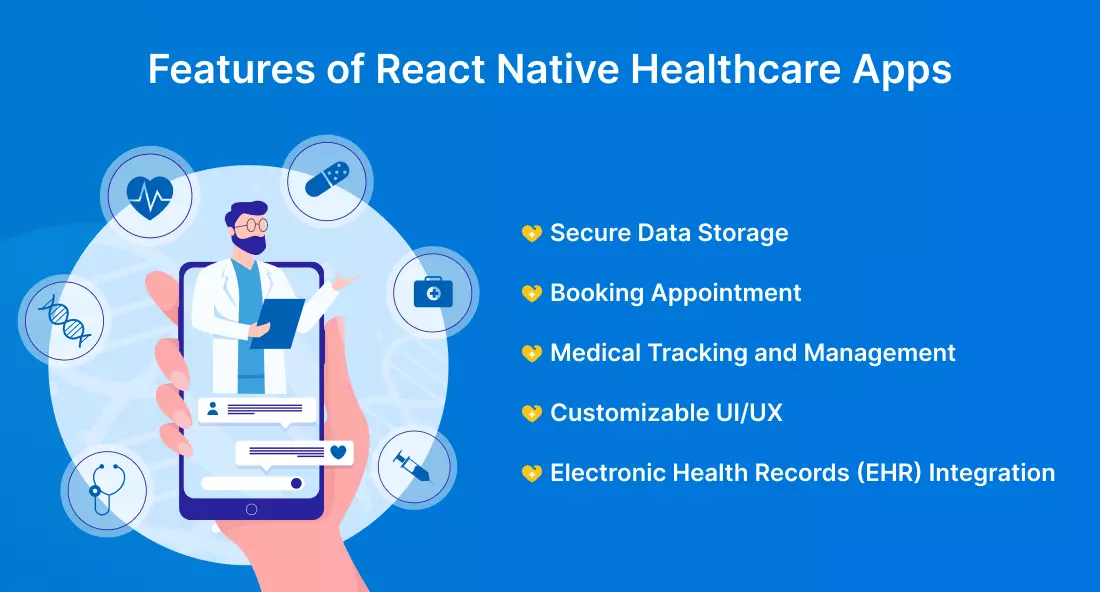
Secure Data Storage
In medical applications, data is crucial because it has all patient records. Securing this data became even more critical, and React Native healthcare app understood that assignment. It allows you to secure and store extensive data.
Here are some React Native features that offer excellent data storage and management options.
- AsyncStorage is a simple, asynchronous, persistent, key-value storage system offered by React Native. You can use it to store some of the app data, like user preferences, settings and authentication tokens.
- React Native supports SQLite (relational database management system), enabling developers to create and manage super smart React Native local databases. Additionally, it manages structured data making it a superior choice for handling complex databases used in healthcare apps.
- React Native Realm is a third-party database library that can be used for faster and secure data storage. Due to its ability to support complex data, real-time data synchronization, and ability to handle larger datasets, healthcare apps get stability and security in data storage.
Booking Appointments
One of the vital features of using a healthcare application is to book appointments rapidly. Several patients don’t want to wait in a queue, and using React Native in healthcare allows you to book an appointment efficiently.
It is developed in such a way that no appointments clash with each other and run systematically. If any appointment is already registered, it will notify users, streamlining the booking process. Well, coming to the core features-
- React Navigation is a library from React Native used to implement smooth and seamless navigation flows for users to browse and book appointments seamlessly.
- Date and time picker is another built-in component offered by React Native. Using it for appointment booking streamlines the process of choosing the preferred date and time for an appointment.
- Redux is a state management library that can be utilized for React Native healthcare app development. It enables the development of a centralized repository for appointment data, ensuring ease of access and consistency throughout the application.
Medical Tracking and Management
React Native facilitates healthcare apps to track and manage medical conditions, treatments, and medications. React Native’s mobile responsive and interactive interface enables seamless data entry.
Also, using React Native’s real-time updates and interface, it becomes easier for you to track and manage health data. As a result, it enhances the communication between the patient and their healthcare provider.
- Access to device sensors is an important element of healthcare apps, and React Native allow seamlessly fulfills this requirement. By accessing device sensors like GPS, accelerometer, and more, it becomes easier to track patients’ location, movement, and activities.
- Camera functionality can be easily integrated into React Native healthcare apps. It helps capture and upload medical images, such as X-rays or lab reports.
- Easy integration with APIs is a specialty of React Native. It allows flawless fetching and displaying real-time data from wearable devices and health monitoring tools.
- React Native, when used for healthcare apps, offers access to a voice recognition feature. You can use this feature to enable hands-free inputs and management for healthcare professionals and patients.
Customizable UI/UX
One of the crucial factors for choosing a healthcare mobile application is the user experience. React Native’s customizable UI components allow you to generate compelling user-friendly interfaces. It enables you to enhance user experience as per the application requirements.
With React Native in health care, you can customize your app’s layout, color scheme, and interactive components, creating engaging healthcare mobile applications. In addition, it gives a personalized and a user-centric approach to your health care app.
- React Native follows a Component-based architecture where UI elements can be broken down into reusable components. It allows easy customization and styling of individual UI components.
- You can leverage the support extended by React Native to Flexbox Layout for creating layouts that adapt to different screen sizes and orientations. It allows you to create powerful, intuitive, responsive, and flexible user interfaces.
- React Native offers built-in support for animated components, allowing developers to create smooth and interactive animated transitions and effects. You can choose versatile React Native animation libraries and UI components to customize UI/UX.
- The Hot Reloading feature from React Native makes it possible to check the UI changes in real-time as you code, thereby making the customization process more efficient and flawless.
Electronic Health Records (EHR) Integration
React Native empowers you to integrate Electronic Health Records (EHR) systems into your mobile healthcare application. EHR integration in healthcare mobile apps enables authorized medical personnel to access and review comprehensive patient information.
With seamless access to data, it becomes easier for professionals to track patients’ medical histories, lab results, diagnoses, medication lists, specific health issues, and treatment plans. React Native’s smooth integration of EHR systems helps to enhance customer care coordination and effective healthcare services.
- Leveraging Native Module Integration, you can integrate native modules written in Swift (for iOS) and Java/Kotlin (for Android) for seamless integration with native EHR libraries and APIs. It ensures a safe and secure data exchange with the EHR systems.
- React Native is the best, when it comes to supporting OAuth and other secure authentication methods. It plays a pivotal role in initiating authorized access to patient data from EHR systems.
- Due to React Native’s flexible architecture, it becomes easier to implement Health Insurance Portability and Accountability Act (HIPAA) compliance measures. It allows for maintaining and managing patient data privacy and security in accordance with healthcare industry standards.
- React Native supports interoperability with various health data standards, such as HL7 (Health Level Seven) and FHIR (Fast Healthcare Interoperability Resources), making it easier to exchange data between the healthcare app and the EHR system.
Want to create dynamic and modern healthcare applications?
Hire React Native developer for faster delivery and empower your app with speed and reliability.
Challenges of Using React Native in Healthcare Applications
When you prefer to use React Native you get the opportunity to unlock the potential of cross-platform app development, yet there are some limitations. Nothing is perfect, and there will always be some hurdles. Likewise, here are the few challenges you face in React Native healthcare application development:
Limited Third-Party Integration
The first challenge in React Native healthcare app development is the limited availability of third-party plugins and modules compared to other native frameworks. Although React Native is a growing ecosystem, it has limited availability of components for specific functionality or APIs.
As a result, you may need to create custom solutions or consider alternative approaches to integrate third-party services. Besides, it increases development time, efforts, and restricts the potential of future development.
Note: Developers can use WebView for creating web-based functionality when native modules are unavailable.
Native Module Integration
Another limitation scenario is when React Native allows cross-platform development; few functionalities need native capabilities that React Native does not directly support within the healthcare application.
Developers can integrate native modules with specific code written for iOS and Android. However, this complex process is time-consuming and requires developers to have native language expertise. Also, the native module integration becomes more complicated and less user-centric.
Performance Optimization
Due to the communication gap between native and JavaScript threads, React Native depends on JavaScript for performance. Eventually, it turns out to be performance bottlenecks, which results in complex tasks and renders unattractive user interfaces.
Also, because of such challenges, your development team must work closely for code optimization. In addition, you need to employ code splitting to decrease initial load time. With proper implementation of code memorization, you enable smooth loading of relevant components to your application.
Regulatory Compliance
The challenges lie in employing robust security measures to protect sensitive information from potential data breaches and unauthorized access. It is vital to follow regulatory compliance in healthcare applications because of the responsibility of the Health Insurance Portability and Accountability Act (HIPAA) or General Data Protection Regulation (GDPR).
Integrating encryption practices into React Native healthcare apps can be technically challenging because it is difficult to maintain encryption keys during data transmission. Also, developing healthcare regulation auditing requires careful tracking and logging user action in the React Native application.
6 Advantages of Using React Native in Healthcare App Development
Let us give you core reasons for choosing React Native in healthcare application development:
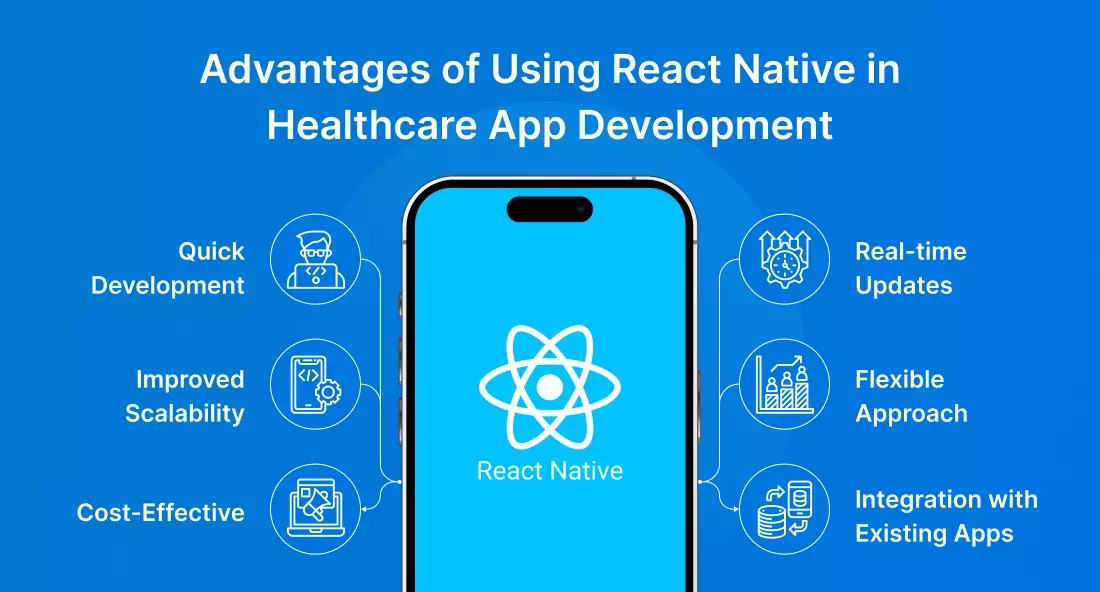
1. Quick Development
React Native offer a streamlined development process and enables developers to create applications smoothly and efficiently. The cross-platform capabilities that employ a single codebase for multiple platforms and an array of substantial React Native elements, helps you harness the development speed of your healthcare application.
As a result, it reduces development time significantly. Also, React Native’s Hot Reloading feature allows your developers to view changes in real-time, which help to make the process faster. Hence, this results in faster development cycles and effective solutions for business owners.
2. Improves Scalability
Scalability is a crucial factor of mobile health applications. Considering the new React Native architecture (React Native v0.70), which is modular and component-based, making it easier for developers to scale the application, even when the user base expands.
Additionally, its compatibility with third-party libraries and plugins enables seamless integration of new features. Also, it ensures that your mobile healthcare application adapts to evolving technology as per the requirements and remains up-to-date with the latest advancements.
3. Cost-Efficiency
As React Native allows using a single code base for Android and iOS, it decreases the development time and cost. Also, it has pre-built components and libraries, which helps you to save development costs efficiently.
In addition, React Native is cost-effective compared to other native app development frameworks because of its code-sharing capabilities across multiple platforms. Hence, 25-30% cost can be reduced by developing healthcare applications with React Native.
Note: Also, you can compare React Native vs Native Development.
4. Real-time Update
In the healthcare industry, real-time updates and information is crucial to ensure the patient receives accurate and latest medical guidance. With React Native’s live updates feature, you can push critical information and update users without requiring them to download new versions from the app store manually.
This capability is particularly beneficial in emergencies, where rapid dissemination of information can make a difference in patient outcomes. In addition, healthcare application using React Native can improve application services.
5. Flexible Approach
Healthcare applications need a flexible approach because the app often needs improvements and updates to meet user requirements and changing industry regulations. React Native’s flexibility allows developers to make changes rapidly and efficiently, which enhances the user experience.
Also, it ensures that the app stays relevant in the dynamic healthcare sector. In addition, React Native has vast community support and continues to improve with the latest technologies, resources, and tools.
6. Integration with Existing Apps
Using React Native in healthcare applications offers seamless integration with existing applications. Its capabilities to integrate with native modules enable healthcare providers to extend their services and reach out to broader communities.
Additionally, React Native simplifies the application process, expands healthcare services, improves patient engagement, and enhances the user interface without redeveloping the application.
Future Trends of React Native in Healthcare Apps
After understanding its core feature and benefits, let us move ahead with the promising future trends of React Native in healthcare apps:
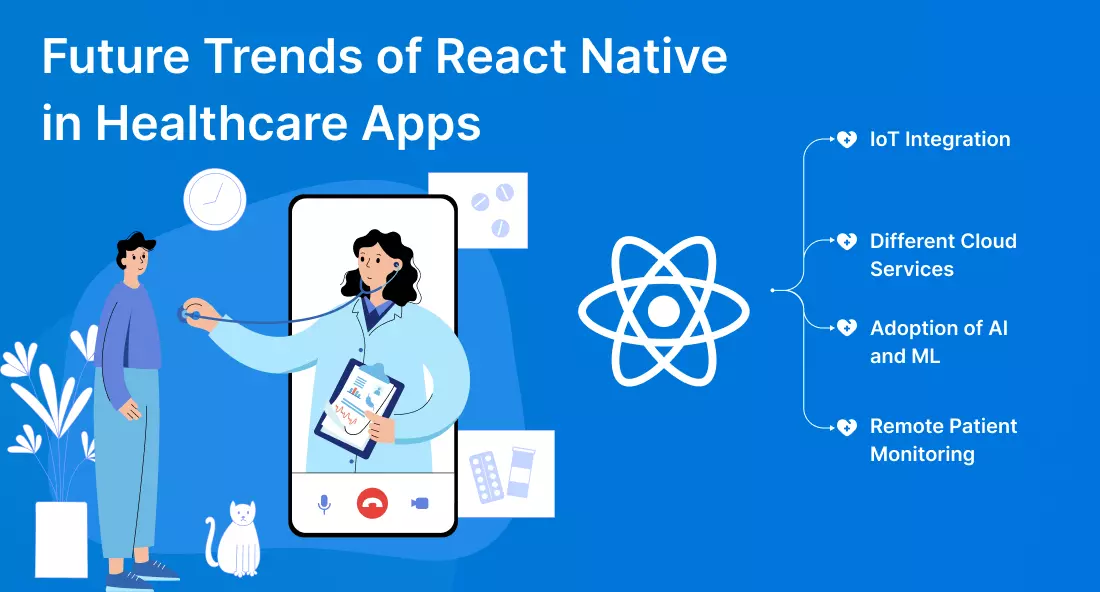
IoT Integration
IoT is evolving and gaining popularity for its smart technology. Healthcare applications using React Native revolutionize how medical services are delivered. IoT devices like wearable watches help to monitor health issues, and smart medical equipment to collect real-time patient data.
React Native’s ability to communicate with IoT devices assists in accessing accurate and continuous patient information, promoting remote monitoring, personalized cure plans, and preventive care. This integration will enhance patient engagement, diagnostics and lead to more proactive healthcare solutions.
Adoption of AI and ML
The use of Artificial Intelligence (AI) and Machine Learning (ML) is increasing in numerous industries; healthcare is no exception. It helps diagnose medical conditions and predict health issues. The fusion of AI/ML technologies with React Native makes it possible to provide a personalized and smart user experience.
You can solve patient or user queries using AI chatbots in less time. Also, with AI-powered applications, you can analyze the information to make well-informed decisions and enhance patient care.
Remote Patient Monitoring
Another latest and promising trend on the list is remote patient monitoring. Using React Native in your healthcare app provides real-time consultations, manages patient vital signs, and shares records with them instantly.
Additionally, the cross-platform functionality allows patients to access telemedicine services from any device, whether it is a smartphone or a tablet. As a result, it ensures convenient and widespread healthcare access. Also, it helps to monitor and track patient records efficiently.
Different Cloud Services
The latest trend in React Native healthcare application is multi-cloud-based services. With React Native, you can provide seamless integration with multiple cloud platforms. Also, it helps to secure sensitive data by saving it in data storage and following privacy regulations.
Whether you are operating for medical research or storing health records, cloud platform integration helps streamline operations in healthcare application. As a result, it makes your app scalable and maintains data security efficiently.
Want to elevate your healthcare app with React Native expertise?
Collaborate with React Native app development company to bring innovative solutions and make your app stand out.
React Native Healthcare App Case Study
Here’s Bacancy’s success story – HormoWell, came to us to develop a healthcare app. We insisted on using React Native for a mobile healthcare application. We not only provided our client with a bespoke mobile app, but the client is enjoying multiple benefits in terms of productivity, user experience, compliance, and security. Let’s look at the challenges, solutions, and how we overcame them by giving him one of the best React Native in healthcare applications:
Overview
HormoWell is a healthcare application that provides evidence-based age management. It helps to identify hormonal imbalances, metabolic syndromes, and sexual problems in both men and women. Our client wanted to upgrade their healthcare application and was looking for a more intuitive solution to make it more user-friendly.
Challenges
🟠 Wanted to update score meter and background color
🟠 Improper patient summary
🟠 Requested to change color and emoji as per user’s mood
Solutions
✅ Used React Native SVG library to fill the background as per the score meter
✅ Utilize Chart Kit Library to enhance patient summary experience
✅ Implement RN-arc-slider to modify color and emoji for users.
Conclusion
A mobile healthcare application is crucial for both – patients and medical professionals; hence, it has to be intuitive and user-friendly. After reading this blog, you must have envisioned why React Native is the ideal framework for creating mobile healthcare applications. No wonder, if you opt for React Native Healthcare Apps; this emerging framework will innovate your application with its dynamic features and cross-platform development ability.
We know the journey is hard, and you need a companion. At Bacancy, we are always there to help. Our prominent React Native development company assists you in developing a modern and secure healthcare mobility app. Also, our experts will craft your healthcare application as per your project’s requirements.
Frequently Asked Questions (FAQs)
It will cost you around $50,000 to $1,40,000 to build a React Native healthcare application. A development cost will be approx $20 to $30 per hour.
Yes, you can create an application solely based on doctor appointments using React Native framework.
Yes, the healthcare application is a good business model because it provides an advantage in this digital era with brilliant social causes.
Your Success Is Guaranteed !
We accelerate the release of digital product and guaranteed their success
We Use Slack, Jira & GitHub for Accurate Deployment and Effective Communication.



